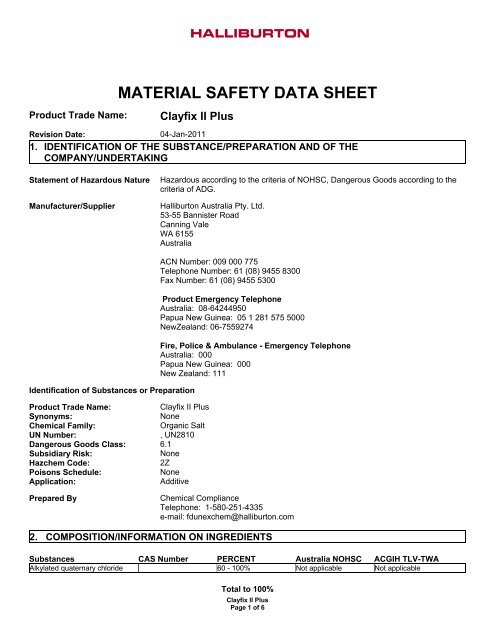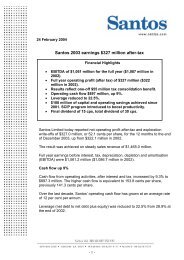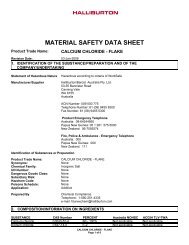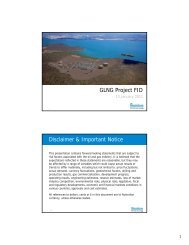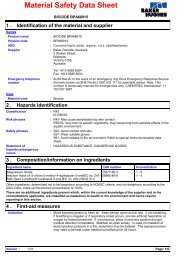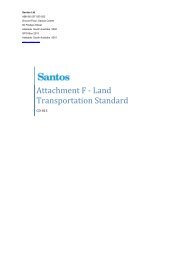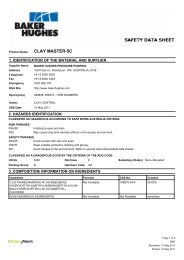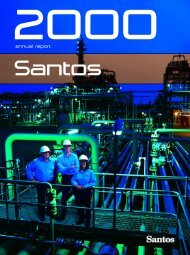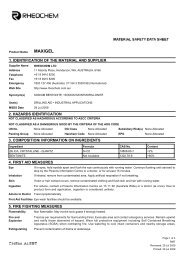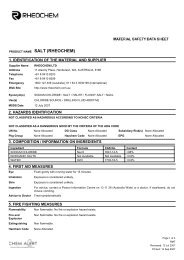Clayfix II Plus - Santos
Clayfix II Plus - Santos
Clayfix II Plus - Santos
Create successful ePaper yourself
Turn your PDF publications into a flip-book with our unique Google optimized e-Paper software.
Product Trade Name:MATERIAL SAFETY DATA SHEET<strong>Clayfix</strong> <strong>II</strong> <strong>Plus</strong>Revision Date:04-Jan-20111. IDENTIFICATION OF THE SUBSTANCE/PREPARATION AND OF THECOMPANY/UNDERTAKINGStatement of Hazardous NatureManufacturer/SupplierHazardous according to the criteria of NOHSC, Dangerous Goods according to thecriteria of ADG.Halliburton Australia Pty. Ltd.53-55 Bannister RoadCanning ValeWA 6155AustraliaIdentification of Substances or PreparationProduct Trade Name:<strong>Clayfix</strong> <strong>II</strong> <strong>Plus</strong>Synonyms:NoneChemical Family:Organic SaltUN Number:, UN2810Dangerous Goods Class: 6.1Subsidiary Risk:NoneHazchem Code:2ZPoisons Schedule:NoneApplication:AdditiveACN Number: 009 000 775Telephone Number: 61 (08) 9455 8300Fax Number: 61 (08) 9455 5300Product Emergency TelephoneAustralia: 08-64244950Papua New Guinea: 05 1 281 575 5000NewZealand: 06-7559274Fire, Police & Ambulance - Emergency TelephoneAustralia: 000Papua New Guinea: 000New Zealand: 111Prepared ByChemical ComplianceTelephone: 1-580-251-4335e-mail: fdunexchem@halliburton.com2. COMPOSITION/INFORMATION ON INGREDIENTSSubstances CAS Number PERCENT Australia NOHSC ACGIH TLV-TWAAlkylated quaternary chloride 60 - 100% Not applicable Not applicableTotal to 100%<strong>Clayfix</strong> <strong>II</strong> <strong>Plus</strong>Page 1 of 6
3. HAZARDS IDENTIFICATIONHazard OverviewMay be fatal if swallowed. May cause eye, skin, and respiratory irritation.Hazard RatingsFlammability: 0Toxicty: 2Body Contact: 0 1Reactivity: 0Chronic: 0Scale: Min/Nil=0 Low=1 Moderate=2 High=3 Extreme=44. FIRST AID MEASURESInhalationSkinEyesIngestionNotes to PhysicianIf inhaled, remove to fresh air. If not breathing give artificial respiration, preferablymouth-to-mouth. If breathing is difficult give oxygen. Get medical attention.Wash with soap and water. Get medical attention if irritation persists.Immediately flush eyes with large amounts of water for at least 15 minutes. Getimmediate medical attention.If swallowed, call a physician immediately. Only induce vomiting at the instruction ofa physician. Never give anything by mouth to an unconscious person.Not Applicable5. FIRE FIGHTING MEASURESSuitable Extinguishing MediaExtinguishing media which mustnot be used for safety reasonsSpecial Exposure HazardsWater fog, carbon dioxide, foam, dry chemical.None known.Decomposition in fire may produce toxic gases. Use water spray to cool fire exposedsurfaces.Special Protective Equipment forFire-Fighters6. ACCIDENTAL RELEASE MEASURESFull protective clothing and approved self-contained breathing apparatus required forfire fighting personnel.Personal Precautionary Measures Use appropriate protective equipment.Environmental PrecautionaryMeasuresProcedure for Cleaning /AbsorptionPrevent from entering sewers, waterways, or low areas.Isolate spill and stop leak where safe. Contain spill with sand or other inert materials.Scoop up and remove.7. HANDLING AND STORAGEHandling PrecautionsWash hands after use. Launder contaminated clothing before reuse. Avoid contactwith eyes, skin, or clothing. Avoid breathing vapors. Do NOT consume food, drink, ortobacco in contaminated areas.<strong>Clayfix</strong> <strong>II</strong> <strong>Plus</strong>Page 2 of 6
Storage InformationStore away from oxidizers. Store in a cool well ventilated area. Keep containerclosed when not in use. Product has a shelf life of 24 months.8. EXPOSURE CONTROLS/PERSONAL PROTECTIONEngineering ControlsRespiratory ProtectionUse in a well ventilated area.If engineering controls and work practices cannot keep exposure below occupationalexposure limits or if exposure is unknown, wear a NIOSH certified, EuropeanStandard EN 149, or equivalent respirator when using this product. Selection of andinstruction on using all personal protective equipment, including respirators, shouldbe performed by an Industrial Hygienist or other qualified professional.Organic vapor/acid gas respirator with a dust/mist filter.Hand ProtectionSkin ProtectionEye ProtectionOther PrecautionsImpervious rubber gloves.Rubber apron.Chemical goggles; also wear a face shield if splashing hazard exists.Eyewash fountains and safety showers must be easily accessible.9. PHYSICAL AND CHEMICAL PROPERTIESPhysical State:LiquidColor:ColorlessOdor:Mild aminepH: 4- 9Specific Gravity @ 20 C (Water=1): 1.035Density @ 20 C (kg/l): 1.11Bulk Density @ 20 C (kg/m 3 ):Not DeterminedBoiling Point/Range (C): 100Freezing Point/Range (C): -40Pour Point/Range (C):Not DeterminedFlash Point/Range (C): Not DeterminedMin: > 93Flash Point Method:PMCCAutoignition Temperature (C):Not DeterminedFlammability Limits in Air - Lower (g/m 3 ):Not DeterminedFlammability Limits in Air - Lower (%):Not DeterminedFlammability Limits in Air - Upper (g/m 3 ):Not DeterminedFlammability Limits in Air - Upper (%):Not DeterminedVapor Pressure @ 20 C (mmHg):Not DeterminedVapor Density (Air=1):Not DeterminedPercent Volatiles:Not DeterminedEvaporation Rate (Butyl Acetate=1):Not DeterminedSolubility in Water (g/100ml):SolubleSolubility in Solvents (g/100ml):Not DeterminedVOCs (g/l):Not DeterminedViscosity, Dynamic @ 20 C (centipoise): 20Viscosity, Kinematic @ 20 C (centistrokes):Not DeterminedPartition Coefficient/n-Octanol/Water:Not DeterminedMolecular Weight (g/mole):Not DeterminedDecomposition Temperature (C):Not Determined10. STABILITY AND REACTIVITYStability Data:Stable<strong>Clayfix</strong> <strong>II</strong> <strong>Plus</strong>Page 3 of 6
Hazardous Polymerization:Conditions to AvoidIncompatibility (Materials toAvoid)Hazardous DecompositionProductsAdditional GuidelinesWill Not OccurNone anticipatedStrong oxidizers.Chlorine. Hydrogen chloride. Oxides of nitrogen. Carbon monoxide and carbondioxide.Not Applicable11. TOXICOLOGICAL INFORMATIONPrinciple Route of ExposureInhalationSkin ContactEye ContactIngestionAggravated Medical ConditionsChronic Effects/CarcinogenicityOther InformationEye or skin contact, inhalation.May cause respiratory irritation.May cause skin irritation. Harmful if absorbed through the skin.Causes eye irritation.May be fatal if swallowed.Eye ailments. Skin disorders.No data available to indicate product or components present at greater than 1% arechronic health hazards.None known.Toxicity TestsOral Toxicity:Dermal Toxicity:Inhalation Toxicity:Primary Irritation Effect:CarcinogenicityGenotoxicity:Reproductive /Developmental Toxicity:LD50: 77 mg/kg (Rat)Not determinedNot determinedNot determinedNot determinedNot determinedNot determined12. ECOLOGICAL INFORMATIONMobility (Water/Soil/Air)Persistence/DegradabilityNot determinedSlowly biodegradableBio-accumulationNot determinedEcotoxicological InformationAcute Fish Toxicity: Not determinedAcute Crustaceans Toxicity:TLM96: 10.5 ppm (Mysidopsis bahia)Acute Algae Toxicity: Not determined<strong>Clayfix</strong> <strong>II</strong> <strong>Plus</strong>Page 4 of 6
Chemical Fate InformationOther InformationNot determinedNot applicable13. DISPOSAL CONSIDERATIONSDisposal MethodContaminated PackagingDisposal should be made in accordance with federal, state, and local regulations.Follow all applicable national or local regulations.14. TRANSPORT INFORMATIONLand TransportationADRUN2810,Toxic Liquid, Organic, N.O.S.(Contains Tetramethylammonium Chloride), 6.1, <strong>II</strong>IAir TransportationICAO/IATAUN2810,Toxic Liquid, Organic, N.O.S., 6.1, <strong>II</strong>I(Contains Tetramethylammonium Chloride Solution)Sea TransportationIMDGUN2810,Toxic Liquid, Organic, N.O.S.(Contains Tetramethylammonium Chloride), 6.1, <strong>II</strong>IEmS F-A, S-AOther Shipping InformationLabels:Toxic15. REGULATORY INFORMATIONChemical InventoriesAustralian AICS InventoryUS TSCA InventoryEINECS InventoryAll components listed.All components listed on inventory or are exempt.This product, and all its components, complies with EINECSClassification T - Toxic.Risk PhrasesR21 Harmful in contact with skin.R25 Toxic if swallowed.R36/37/38 Irritating to eyes, respiratory system and skin.Safety PhrasesS26 In case of contact with eyes, rinse immediately with plenty of water and seekmedical advice.S45 In case of accident or if you feel unwell, seek medical advice immediately.S37/39 Wear suitable gloves and eye/face protection.<strong>Clayfix</strong> <strong>II</strong> <strong>Plus</strong>Page 5 of 6
16. OTHER INFORMATIONThe following sections have been revised since the last issue of this MSDSNot applicableContactAustralian Poisons Information Centre24 Hour Service: - 13 11 26Police or Fire Brigade: - 000 (exchange): - 1100New Zealand National Poisons Centre0800 764 766Additional InformationFor additional information on the use of this product, contact your local Halliburtonrepresentative.For questions about the Material Safety Data Sheet for this or other Halliburtonproducts, contact Chemical Compliance at 1-580-251-4335.Disclaimer StatementThis information is furnished without warranty, expressed or implied, as to accuracyor completeness. The information is obtained from various sources including themanufacturer and other third party sources. The information may not be valid underall conditions nor if this material is used in combination with other materials or in anyprocess. Final determination of suitability of any material is the sole responsibility ofthe user.***END OF MSDS***<strong>Clayfix</strong> <strong>II</strong> <strong>Plus</strong>Page 6 of 6


